Topics
Category
Era
Sixteenth Battalion, Minnesota Home Guard
Members of Company A, Sixteenth Battalion of the Minnesota Home Guard, ca.1918. Standing at right is Captain Clarence Wigington, who petitioned the governor to allow the formation of an African American unit. To his left is Lieutenant Homer Goins. Seated (L to R) are Dr. George Berry and Sergeant William Griffin. The remaining pictured are unidentified.
During World War I, African American Minnesotans wanted to serve their state and their nation. Historically, however, the U.S. military had been racist in its recruiting. It allowed African Americans to serve only in segregated units. Facing this institutional racism, the African American community of Minnesota asked Governor J.A.A. Burnquist to form an all-African American battalion of the Minnesota Home Guard. The Sixteenth Battalion became the first Minnesota-recruited African American military unit in state history.
When the Minnesota National Guard was federalized in the spring of 1917, the state was left without any military organization. To defend the home front the Minnesota Commission of Public Safety created the Minnesota Home Guard. The Home Guard existed for the duration of World War I. Units performed civilian and military duties.
Minnesota’s Home Guard units followed the racist recruiting policies of the U.S. military. Still, African American men saw the Home Guard as an opportunity. A leader in the community named Clarence Wigington petitioned Governor Burnquist to form an all-African American battalion of the Home Guard. In the racist climate that prevailed, a “separate but equal” unit was the most feasible option.
On April 20, 1918, nearly a year after the creation of the Home Guard, the all-African American Sixteenth Battalion was ordered to form. Before this order was received, companies A and B formed in St. Paul. Led by Wigington, African American men met at the old state capitol building. Wigington gave an address; afterward, the men were sworn in. Wigington became captain of Company A. Orrington C. Hall led Company B.
On April 26, 1918, companies C and D formed in Minneapolis and were sworn in at city hall. Gale C. Hilyer led Company C and Charles Sumner Smith captained Company D. A medical corps headed by Dr. Valdo Turner formed. About five hundred men enlisted in the battalion overall, with Major Jose H. Sherwood in command. The Sixteenth also had a band and drum corps. The band was led by Professor William H. Howard and the drum corps by Charles Miller.
The officers of the Sixteenth were all men of color. Due to the poor treatment they received when trying to enlist, the men of the battalion demanded that their officers be of their own race. The Adjutant General’s office agreed. As the companies formed some whites criticized the state government for allowing African Americans to become officers.
After its formation the battalion became active. Spanish American War veterans and ex-regulars ensured the battalion was well drilled. Each company began a schedule of drilling every week. On Memorial Day in 1918 it marched in parades alongside all white Home Guard units in both Minneapolis and St. Paul. The men did not have uniforms at the time but wore white gloves. According to newspaper accounts, the battalion received special applause from the crowd.
The African American community of the Twin Cities embraced the battalion. There were patriotic rallies and parades and the battalion band became popular. It played at community events, dances, and battalion drills. The Sixteenth escorted African American draftees to the train station. The battalion also provided a line of communication between the state government and the African American community.
During the summer of 1918 the battalion experienced infighting. Some men felt they should be in charge because they had military experience, which most of the officers lacked. Many expressed a desire to leave the unit. Discipline was not maintained. Attendance suffered, but the battalion continued to host events.
When World War I ended, Home Guard units began to muster out. The Sixteenth continued to operate. Its band played concerts as late as February 1919. Determined to continue serving, leaders of the battalion pushed for the unit to be inducted into the Minnesota National Guard.
On April 25, 1919, the Minnesota Legislature approved the formation of a separate battalion in addition to units of the Minnesota National Guard. This new unit was composed of the Sixteenth Battalion and was officially designated the First Infantry Battalion of the Minnesota Militia. Some African American veterans returning from overseas joined the new unit. The African American men of this unit were not officially part of the Minnesota National Guard. Like the Sixteenth, it was a segregated unit.
Bibliography
“Battalion Band Smoker a Pleasant Affair.” Minneapolis Twin City Star, November 9, 1918.
Buell, C.J. The Minnesota Legislature of 1919. [St. Paul?: C.J. Buell, 1919?].
http://www.leg.state.mn.us/docs/NonMNpub/oclc00500242.pdf
“Commissions Negro Minnesota Home Guard.” Minneapolis Twin City Star, June 15, 1918.
A/.K18
Edward Karrow Scrapbooks, 1917–1925
Manuscript Collection, Minnesota Historical Society, St. Paul
Description: Edward Karrow served in several military organizations during World War I. His scrapbooks include official rosters of the Minnesota National Guard after World War I. These rosters include the unit which the old Sixteenth Battalion formed after the war. The unit was designated the First Battalion of Infantry, Minnesota Militia.
Hilyer, Gale C. “Home Guards to Uniform.” Minneapolis Twin City Star, August 31, 1918.
“Home Guard Friction.” Minneapolis Twin City Star, August 17, 1918.
“Home Guard Notice.” St. Paul Appeal, April 6, 1918.
http://chroniclingamerica.loc.gov/lccn/sn83016810/1918-04-06/ed-1/seq-3/
Home Guard Records, 1917–1919
Minnesota National Guard
State Archives Collection, Minnesota Historical Society, St. Paul
http://www2.mnhs.org/library/findaids/gr00862.xml
Description: Records documenting the duties and activities of the Home Guard by battalion. Enlistment records of the Sixteenth Battalion, and miscellaneous correspondence written by some of its members is included.
“Hurrah! Hurrah! Hurrah!” St. Paul Appeal, May 25, 1918.
http://chroniclingamerica.loc.gov/lccn/sn83016810/1918-05-25/ed-1/seq-3/
“Maj. Curtis Commissions Negro Home Guard Officers.” Minneapolis Twin City Star, May 11, 1918.
SAM 1
Military Service Record Cards, [c.1860]–[c.1945]
Minnesota Office of the Adjutant General
State Archives Collection, Minnesota Historical Society, St. Paul
http://www2.mnhs.org/library/findaids/sam001.xml
Description: The collection includes cards which provide information about individuals who served in the Minnesota Home Guard during World War I. Records of the Sixteenth Battalion are included.
Minnesota 41st Legislature. “An act relating to the organization and equipment of an additional battalion of infantry for the Minnesota National Guard.” April 25, 1919.
https://www.revisor.mn.gov/laws/?year=1919&type=0&doctype=Chapter&id=472
“Negro Assistant to Adjutant General.” Minneapolis Twin City Star, October 26, 1918
“Negro Captain Serves on Staff of Adjutant-General During Fire Trouble.” Minneapolis Twin City Star, October 19, 1918.
“Negro Home Guards Receive Ovation on Memorial Day.” Minneapolis Twin City Star, June 1, 1918.
“Negro Nurses Wanted.” Minneapolis Twin City Star, July 20, 1918.
“Negroes to Organize a Home Guard Unit.” Minneapolis Twin City Star, April 20, 1918.
“Plan Negro Guard Units.” Minneapolis Twin City Star, December 7, 1918.
“Revive the Home Guards.” Minneapolis Twin City Star, November 23, 1918.
Rhinow, W. F. Report of the Adjutant General of the State of Minnesota covering the Thirteenth Biennial Period Ending December 31, 1918. Vol. 1. Minneapolis, MN: Syndicate Printing Co., 1918.
http://books.google.com/books?id=Gj4WAAAAYAAJ&pg=PA340&lpg=PA340&dq=adjutant+general+report+minnesota+1917&source=bl&ots=kAV2FAUdZN&sig=PU11b3ruDqwx98vWiZARSUQ-8js&hl=en&sa=X&ei=JMkuVIK4GY-hyATivoKgAg&ved=0CCEQ6AEwAQ#v=onepage&q&f=false
“Sherwood Appointed Major.” Minneapolis Twin City Star, May 25, 1918.
Taylor, David Vassar. Cap Wigington: An Architectural Legacy in Ice and Stone. St. Paul: Minnesota Historical Society Press, 2001.
“The Drafted Men Leave Saturday, Aug. 3.” Minneapolis Twin City Star, August 3, 1918.
“The Negro Home Guard.” Minneapolis Twin City Star, April 13, 1918.
“Two Home Guard Companies.” Minneapolis Twin City Star, April 27, 1918.
Wigington, Clarence W. “Home Guard Notice.” St. Paul Appeal, April 20, 1918.
http://chroniclingamerica.loc.gov/lccn/sn83016810/1918-04-20/ed-1/seq-3/
“16th Battalion Band.” Minneapolis Twin City Star, June 8, 1918.
“16th Battalion in Reserve.” Minneapolis Twin City Star, September 19, 1918.
Related Resources
Primary
“A Bad Bill.” St. Paul Appeal, February 22, 1919.
http://chroniclingamerica.loc.gov/lccn/sn83016810/1919-02-22/ed-1/seq-3/
“A Bad Precedent.” St. Paul Appeal, March 1, 1919.
http://chroniclingamerica.loc.gov/lccn/sn83016810/1919-02-01/ed-1/seq-3/
“Co. D Dance a Success.” Minneapolis Twin City Star, November 30, 1918.
Collected Materials, 1917–[192–]
Minnesota War Records Commission
State Archives Collection, Minnesota Historical Society, St. Paul
Description: Papers of individuals, records of organizations, and printed materials relating to wartime activities, collected or compiled by the War Records Commission. Orders for several Home Guard units are included in the collection.
“Company D Drill.” Minneapolis Twin City Star, May 25, 1918.
“Drafted Men Entertain.” Minneapolis Twin City Star, September 7, 1918.
“Emancipation Celebration is a Big and Inspiring Event.” Minneapolis Twin City Star, August 3, 1918.
“Flag Day Parade.” Minneapolis Twin City Star, June 8, 1918.
“Hollow Rink Drill Grounds.” St. Paul Appeal, June 29, 1918.
http://chroniclingamerica.loc.gov/lccn/sn83016810/1918-06-29/ed-1/seq-4/
“Home Guard Enlistment.” St. Paul Appeal, April 20, 1918.
http://chroniclingamerica.loc.gov/lccn/sn83016810/1918-04-20/ed-1/seq-3/
“Home Guard Notice—16th Battalion.” Minneapolis Twin City Star, July 6, 1918.
“Memorial Day Parade.” Minneapolis Twin City Star, May 25, 1918.
“Musical Concert and Ball by the Sixteenth Battalion Band.” Minneapolis Twin City Star, January 25, 1919.
“Second Draft Leaves for Camp Dodge.” Minneapolis Twin City Star, August 10, 1918.
“St. Paul Home Guards.” Minneapolis Twin City Star, September 28, 1918.
“Successful Band Concert.” Minneapolis Twin City Star, October 5, 1918.
“Successful Military Exhibition and Dance.” Minneapolis Twin City Star, September 7, 1918.
Secondary
Chislock, Carl H. Watchdog of Loyalty: The Minnesota Commission of Public Safety During World War I. St. Paul: Minnesota Historical Society Press, 1991.
Holbrook, Franklin F. ed. St. Paul and Ramsey County in the War of 1917–1918. St. Paul, MN: Ramsey County War Records Commission, 1929.
——— , and Livia Appel. Minnesota in the War with Germany. 2 vols. St. Paul: Minnesota Historical Society, 1928.
Taylor, David Vassar. “The Blacks” In They Chose Minnesota: A Survey of the State’s Ethnic Groups. June Drenning Holmquist ed., 73–91. St. Paul: Minnesota Historical Society Press, 1981.
——— . “Pilgrim’s Progress: Black St. Paul and the Making of an Urban Ghetto, 1870–1930.” Ph.D. Thesis, University of Minnesota, 1977.
Web
Bryan, Jamie. “Fighting for Respect: African-American Soldiers in WWI.” MilitaryHistoryOnline.com, 2003.
http://www.militaryhistoryonline.com/wwi/articles/fightingforrespect.aspx
Related Images
Members of Company A, Sixteenth Battalion of the Minnesota Home Guard, ca.1918. Standing at right is Captain Clarence Wigington, who petitioned the governor to allow the formation of an African American unit. To his left is Lieutenant Homer Goins. Seated (L to R) are Dr. George Berry and Sergeant William Griffin. The remaining pictured are unidentified.
Charles Sumner Smith was Captain of Company D of the Sixteenth Battalion, Minnesota Home Guard. He was a founding member of the Twin Cities Protective League and the Minneapolis NAACP. After the Duluth lynchings he helped with the founding of the Duluth NAACP. Image is from the St. Paul Appeal, August 25, 1917.
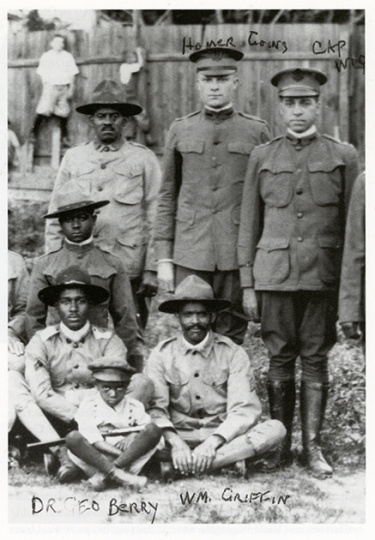
Members of Company A, Sixteenth Battalion of the Minnesota Home Guard
Members of Company A, Sixteenth Battalion of the Minnesota Home Guard, ca.1918. Standing at right is Captain Clarence Wigington, who petitioned the governor to allow the formation of an African American unit. To his left is Lieutenant Homer Goins. Seated (L to R) are Dr. George Berry and Sergeant William Griffin. The remaining pictured are unidentified.
Public domain
Holding Location

Members of the Sixteenth Battalion of the Minnesota Home Guard
Members of the Sixteenth Battalion of the Minnesota Home Guard, c.1918. After petitioning the governor, African American citizens formed their own battalion in order to serve.
Public domain
Holding Location
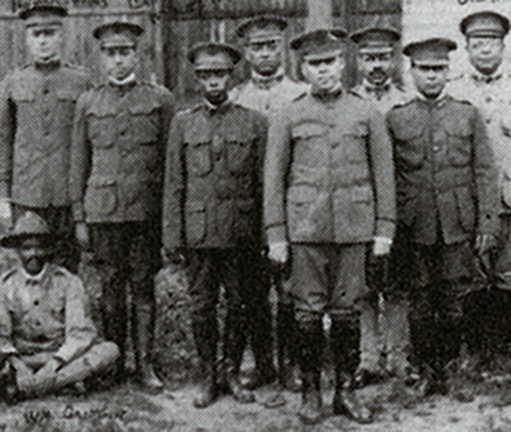
Officers of the Sixteenth Battalion, Minnesota Home Guard
Officers of the Sixteenth Battalion, Minnesota Home Guard, c.1918. (L to R) Lt. Homer Goins, Capt. Clarence Wigington, Lt. Patrick H. Southall, unidentified, Major Jose H. Sherwood, unidentified, unidentified, Capt. Orrington C. Hall.
Public domain
Holding Location
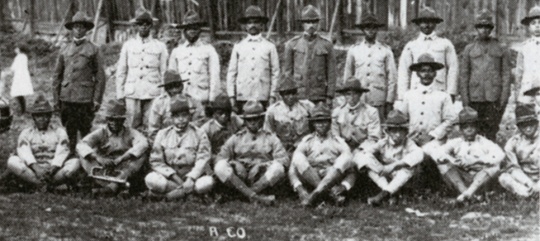
Enlisted men of the Sixteenth Battalion, Minnesota Home Guard
Enlisted men of the Sixteenth Battalion, Minnesota Home Guard, c.1918.
Public domain
Holding Location
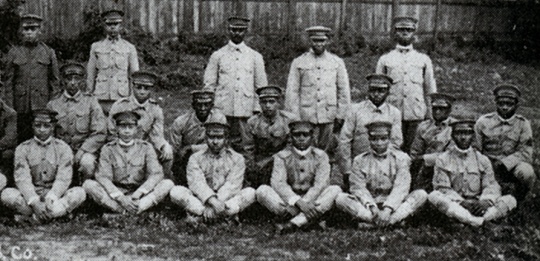
Men of the Sixteenth Battalion of the Minnesota Home Guard
Men of the Sixteenth Battalion of the Minnesota Home Guard, c.1918.
Public domain
Holding Location
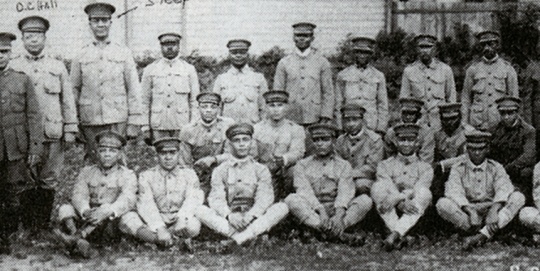
Men and officers of the Sixteenth Battalion, Minnesota Home Guard
Men and officers of the Sixteenth Battalion, Minnesota Home Guard, c.1918. Officers (L to R) are Capt. Orrington C. Hall and Lt. Thaddeus Stepp.
Public domain
Holding Location

Sixteenth Battalion musicians
Musicians of the Sixteenth Battalion Band, c.1918.
Public domain
Holding Location
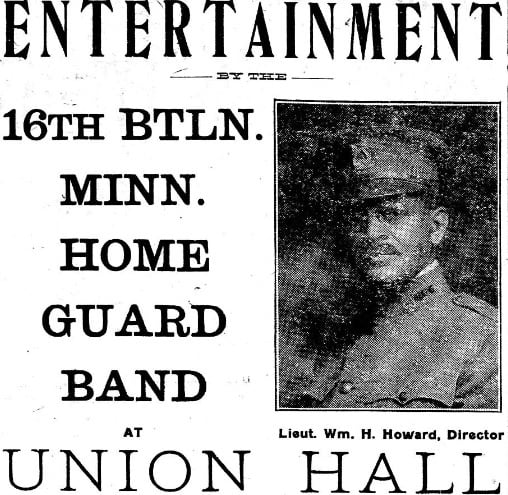
Advertisement for Sixteenth Battalion Band concert
An advertisement for a concert put on by the Sixteenth Battalion Band from the St. Paul Appeal, October 25, 1919. The band was led by Lieutenant William Howard.
Public domain
Holding Location
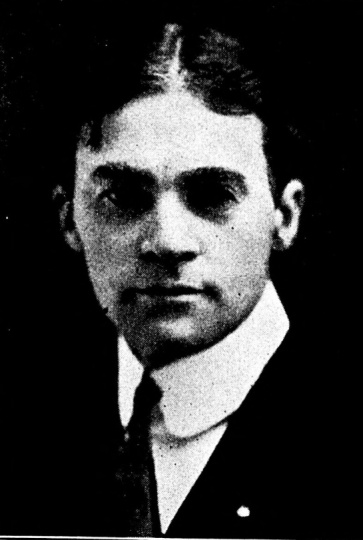
George W. Holbert
George W. Holbert, c.1911. Holbert was Second Lt. of Company C of the Sixteenth Battalion, Minnesota Home Guard. Image is from the St. Paul Appeal, October 28, 1911.
Public domain
Holding Location
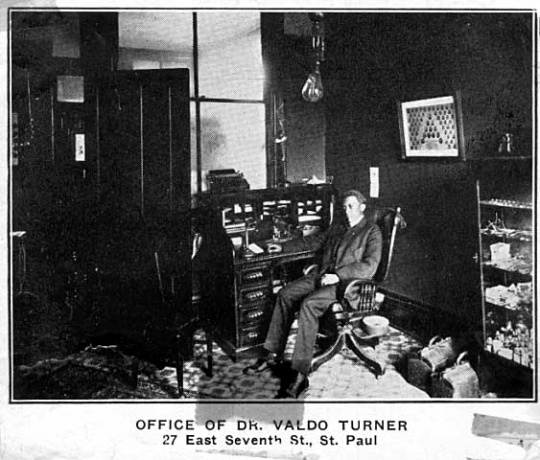
Dr. Valdo Turner
Dr. Valdo Turner in his office, ca.1915. Turner was vice president of the St. Paul NAACP and captain of the Sixteenth Battalion Medical Corps, Minnesota Home Guard.
Public domain
Holding Location
More Information
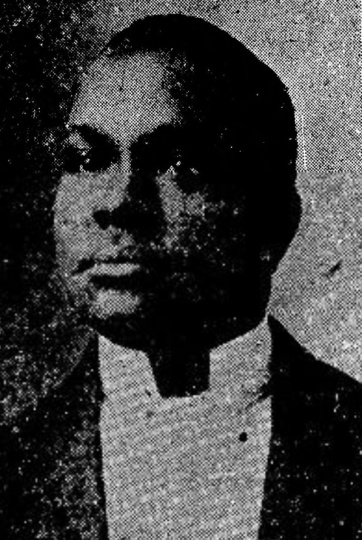
Charles H. Miller
Charles Miller was a founding member of the St. Paul NAACP and led the Sixteenth Battalion Drum Corps. Image is from the St. Paul Appeal, March 31, 1917.
Public domain
Holding Location
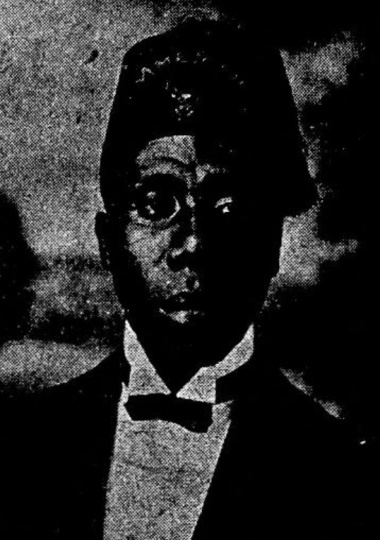
Patrick. H. Southall
Patrick. H. Southall was Second Lt. of Company D of the Sixteenth Battalion, Minnesota Home Guard. Image is from the St. Paul Appeal, March 31, 1917.
Public domain
Holding Location
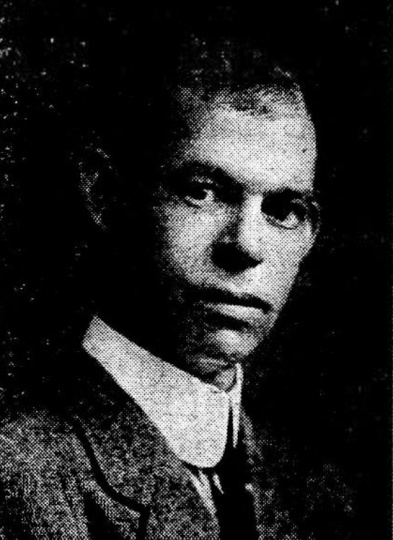
Charles Sumner Smith
Charles Sumner Smith was Captain of Company D of the Sixteenth Battalion, Minnesota Home Guard. He was a founding member of the Twin Cities Protective League and the Minneapolis NAACP. After the Duluth lynchings he helped with the founding of the Duluth NAACP. Image is from the St. Paul Appeal, August 25, 1917.
Public domain
Holding Location
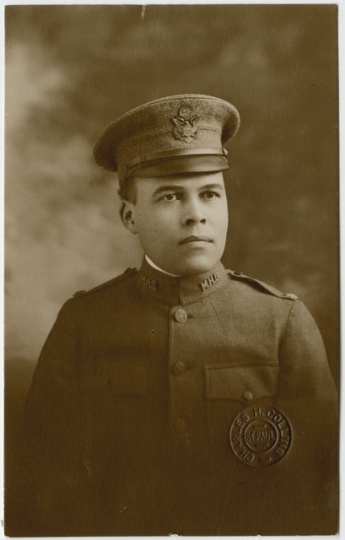
Major Jose H. Sherwood
Major Jose H. Sherwood, 1918. Sherwood commanded the Sixteenth Battalion of the Minnesota Home Guard.
Public domain
Holding Location
More Information
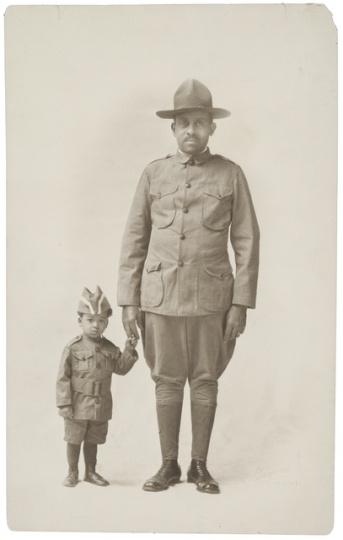
Dr. Obadiah D. Howard, Sergeant in the Sixteenth Battalion of the Minnesota Home Guard, and his grandson
Dr. Obadiah D. Howard, Sergeant in the Sixteenth Battalion of the Minnesota Home Guard, and his grandson, Howard Maxwell, 1918.
Public domain
Holding Location
More Information
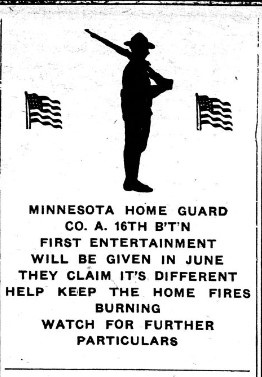
Sixteenth Battalion event advertisement
Advertisement for an event hosted by Company A of the Sixteenth Battalion, Minnesota Home Guard. Image is from the St. Paul Appeal, May 25, 1918.
Public domain
Holding Location
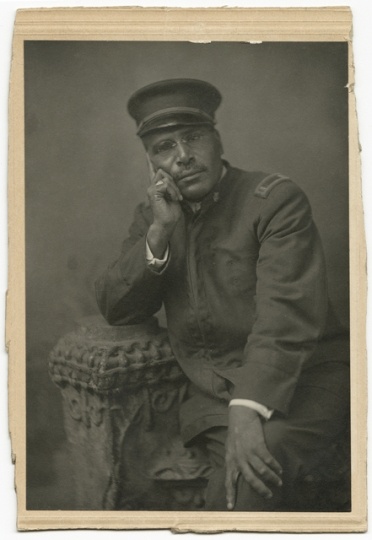
William H. Howard
Lt. William H. Howard, c.1919. Howard was the leader of the Sixteenth Battalion Band.
Public domain
Holding Location
More Information

Gale Pillsbury Hilyer
Gale Pillsbury Hilyer, ca.1919. Hilyer was captain of Company C of the Sixteenth Battalion, Minnesota Home Guard and a founding member of the Minneapolis NAACP. Image is from the Minneapolis National Advocate, March 15, 1919.
Public domain
Holding Location
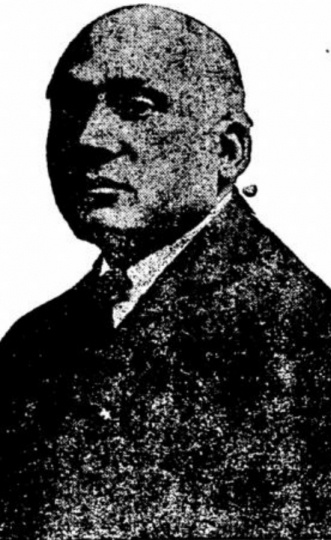
William R. Morris
William R. Morris, ca.1919. Morris became captain of Company D of the Sixteenth Battalion, Minnesota Home Guard and was also a founding member of the Minneapolis NAACP. Image is from the Minneapolis National Advocate, March 15, 1919.
Public domain
Holding Location
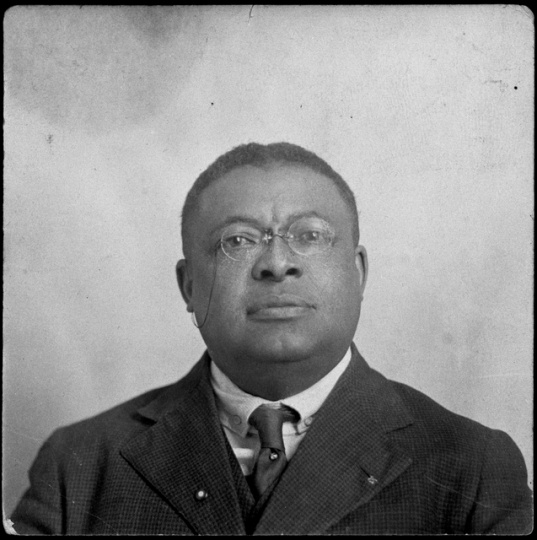
Orrington C. Hall
Orrington C. Hall, ca.1920. Hall commanded Company B of the Sixteenth Battalion, Minnesota Home Guard. He was also a founding member of the St. Paul NAACP.
Public domain
Holding Location
More Information
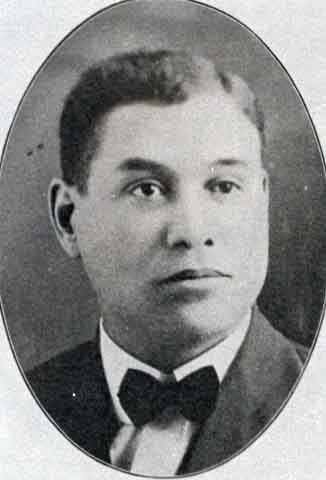
George L. Hoage
George L. Hoage, 1924. Hoage was supply officer for the Sixteenth Battalion, Minnesota Home Guard.
Public domain
Holding Location
More Information
Related Articles
Turning Point
Preempting official orders, African American men in St. Paul meet at the old state capitol building on April 11, 1918, to begin organizing an all-African American battalion of the Minnesota Home Guard.
Chronology
April 28, 1917
1918
April 11, 1918
April 20, 1918
April 26, 1918
May 25, 1918
May 27, 1918
June 14, 1918
August 1918
Septem-ber 2, 1918
October 1918
November 1918
November 25, 1918
April 25, 1919
December 15, 1920
March 21, 1921
Bibliography
“Battalion Band Smoker a Pleasant Affair.” Minneapolis Twin City Star, November 9, 1918.
Buell, C.J. The Minnesota Legislature of 1919. [St. Paul?: C.J. Buell, 1919?].
http://www.leg.state.mn.us/docs/NonMNpub/oclc00500242.pdf
“Commissions Negro Minnesota Home Guard.” Minneapolis Twin City Star, June 15, 1918.
A/.K18
Edward Karrow Scrapbooks, 1917–1925
Manuscript Collection, Minnesota Historical Society, St. Paul
Description: Edward Karrow served in several military organizations during World War I. His scrapbooks include official rosters of the Minnesota National Guard after World War I. These rosters include the unit which the old Sixteenth Battalion formed after the war. The unit was designated the First Battalion of Infantry, Minnesota Militia.
Hilyer, Gale C. “Home Guards to Uniform.” Minneapolis Twin City Star, August 31, 1918.
“Home Guard Friction.” Minneapolis Twin City Star, August 17, 1918.
“Home Guard Notice.” St. Paul Appeal, April 6, 1918.
http://chroniclingamerica.loc.gov/lccn/sn83016810/1918-04-06/ed-1/seq-3/
Home Guard Records, 1917–1919
Minnesota National Guard
State Archives Collection, Minnesota Historical Society, St. Paul
http://www2.mnhs.org/library/findaids/gr00862.xml
Description: Records documenting the duties and activities of the Home Guard by battalion. Enlistment records of the Sixteenth Battalion, and miscellaneous correspondence written by some of its members is included.
“Hurrah! Hurrah! Hurrah!” St. Paul Appeal, May 25, 1918.
http://chroniclingamerica.loc.gov/lccn/sn83016810/1918-05-25/ed-1/seq-3/
“Maj. Curtis Commissions Negro Home Guard Officers.” Minneapolis Twin City Star, May 11, 1918.
SAM 1
Military Service Record Cards, [c.1860]–[c.1945]
Minnesota Office of the Adjutant General
State Archives Collection, Minnesota Historical Society, St. Paul
http://www2.mnhs.org/library/findaids/sam001.xml
Description: The collection includes cards which provide information about individuals who served in the Minnesota Home Guard during World War I. Records of the Sixteenth Battalion are included.
Minnesota 41st Legislature. “An act relating to the organization and equipment of an additional battalion of infantry for the Minnesota National Guard.” April 25, 1919.
https://www.revisor.mn.gov/laws/?year=1919&type=0&doctype=Chapter&id=472
“Negro Assistant to Adjutant General.” Minneapolis Twin City Star, October 26, 1918
“Negro Captain Serves on Staff of Adjutant-General During Fire Trouble.” Minneapolis Twin City Star, October 19, 1918.
“Negro Home Guards Receive Ovation on Memorial Day.” Minneapolis Twin City Star, June 1, 1918.
“Negro Nurses Wanted.” Minneapolis Twin City Star, July 20, 1918.
“Negroes to Organize a Home Guard Unit.” Minneapolis Twin City Star, April 20, 1918.
“Plan Negro Guard Units.” Minneapolis Twin City Star, December 7, 1918.
“Revive the Home Guards.” Minneapolis Twin City Star, November 23, 1918.
Rhinow, W. F. Report of the Adjutant General of the State of Minnesota covering the Thirteenth Biennial Period Ending December 31, 1918. Vol. 1. Minneapolis, MN: Syndicate Printing Co., 1918.
http://books.google.com/books?id=Gj4WAAAAYAAJ&pg=PA340&lpg=PA340&dq=adjutant+general+report+minnesota+1917&source=bl&ots=kAV2FAUdZN&sig=PU11b3ruDqwx98vWiZARSUQ-8js&hl=en&sa=X&ei=JMkuVIK4GY-hyATivoKgAg&ved=0CCEQ6AEwAQ#v=onepage&q&f=false
“Sherwood Appointed Major.” Minneapolis Twin City Star, May 25, 1918.
Taylor, David Vassar. Cap Wigington: An Architectural Legacy in Ice and Stone. St. Paul: Minnesota Historical Society Press, 2001.
“The Drafted Men Leave Saturday, Aug. 3.” Minneapolis Twin City Star, August 3, 1918.
“The Negro Home Guard.” Minneapolis Twin City Star, April 13, 1918.
“Two Home Guard Companies.” Minneapolis Twin City Star, April 27, 1918.
Wigington, Clarence W. “Home Guard Notice.” St. Paul Appeal, April 20, 1918.
http://chroniclingamerica.loc.gov/lccn/sn83016810/1918-04-20/ed-1/seq-3/
“16th Battalion Band.” Minneapolis Twin City Star, June 8, 1918.
“16th Battalion in Reserve.” Minneapolis Twin City Star, September 19, 1918.
Related Resources
Primary
“A Bad Bill.” St. Paul Appeal, February 22, 1919.
http://chroniclingamerica.loc.gov/lccn/sn83016810/1919-02-22/ed-1/seq-3/
“A Bad Precedent.” St. Paul Appeal, March 1, 1919.
http://chroniclingamerica.loc.gov/lccn/sn83016810/1919-02-01/ed-1/seq-3/
“Co. D Dance a Success.” Minneapolis Twin City Star, November 30, 1918.
Collected Materials, 1917–[192–]
Minnesota War Records Commission
State Archives Collection, Minnesota Historical Society, St. Paul
Description: Papers of individuals, records of organizations, and printed materials relating to wartime activities, collected or compiled by the War Records Commission. Orders for several Home Guard units are included in the collection.
“Company D Drill.” Minneapolis Twin City Star, May 25, 1918.
“Drafted Men Entertain.” Minneapolis Twin City Star, September 7, 1918.
“Emancipation Celebration is a Big and Inspiring Event.” Minneapolis Twin City Star, August 3, 1918.
“Flag Day Parade.” Minneapolis Twin City Star, June 8, 1918.
“Hollow Rink Drill Grounds.” St. Paul Appeal, June 29, 1918.
http://chroniclingamerica.loc.gov/lccn/sn83016810/1918-06-29/ed-1/seq-4/
“Home Guard Enlistment.” St. Paul Appeal, April 20, 1918.
http://chroniclingamerica.loc.gov/lccn/sn83016810/1918-04-20/ed-1/seq-3/
“Home Guard Notice—16th Battalion.” Minneapolis Twin City Star, July 6, 1918.
“Memorial Day Parade.” Minneapolis Twin City Star, May 25, 1918.
“Musical Concert and Ball by the Sixteenth Battalion Band.” Minneapolis Twin City Star, January 25, 1919.
“Second Draft Leaves for Camp Dodge.” Minneapolis Twin City Star, August 10, 1918.
“St. Paul Home Guards.” Minneapolis Twin City Star, September 28, 1918.
“Successful Band Concert.” Minneapolis Twin City Star, October 5, 1918.
“Successful Military Exhibition and Dance.” Minneapolis Twin City Star, September 7, 1918.
Secondary
Chislock, Carl H. Watchdog of Loyalty: The Minnesota Commission of Public Safety During World War I. St. Paul: Minnesota Historical Society Press, 1991.
Holbrook, Franklin F. ed. St. Paul and Ramsey County in the War of 1917–1918. St. Paul, MN: Ramsey County War Records Commission, 1929.
——— , and Livia Appel. Minnesota in the War with Germany. 2 vols. St. Paul: Minnesota Historical Society, 1928.
Taylor, David Vassar. “The Blacks” In They Chose Minnesota: A Survey of the State’s Ethnic Groups. June Drenning Holmquist ed., 73–91. St. Paul: Minnesota Historical Society Press, 1981.
——— . “Pilgrim’s Progress: Black St. Paul and the Making of an Urban Ghetto, 1870–1930.” Ph.D. Thesis, University of Minnesota, 1977.
Web
Bryan, Jamie. “Fighting for Respect: African-American Soldiers in WWI.” MilitaryHistoryOnline.com, 2003.
http://www.militaryhistoryonline.com/wwi/articles/fightingforrespect.aspx






















